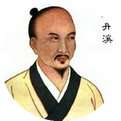
This article is summarized and organized based on the “Lecture Notes on Basic Theories of Traditional Chinese Medicine” by Li Dexin, published by Renwei Press.
Abnormalities of body fluids refer to insufficient generation of body fluids, or abnormal distribution and excretion, leading to slow circulation of body fluids within the body, resulting in pathological changes such as fluid retention, obstruction, and overflow. This mainly includes two aspects: insufficient body fluids and accumulation of dampness.
1. Insufficient Body Fluids
Insufficient body fluids refer to the deficiency of body fluids, leading to pathological changes characterized by dryness and lack of moisture.
The pathological characteristics of insufficient body fluids are the loss of body fluids, with the nature of the disease being deficiency with excess heat.
Insufficient body fluids are often caused by dryness-heat pathogens or the fire of the five emotions, or high fever, excessive sweating, vomiting, diarrhea, excessive urination, blood loss, or overuse of pungent and drying agents, which consume body fluids and subsequently lead to the internal organs and external orifices, skin and hair losing their moisture.
The pathological changes of insufficient body fluids vary depending on the degree of fluid deficiency, which can be classified into damage to body fluids and damage to yin.
For example, excessive sweating in hot summer or thirst due to high fever; in dry seasons, common symptoms include dryness of the mouth, nose, and skin, which belong to the clinical manifestations primarily of body fluid damage.
In the later stages of febrile diseases, prolonged illness can damage yin, leading to symptoms such as a bright red tongue with little or no coating, dry lips and tongue, emaciation, and dry hair, which are clinical manifestations of depleted yin fluids and the movement of wind.
Damage to body fluids and loss of fluids: Although there are differences in the mechanisms and clinical manifestations, body fluids and liquid are originally one entity, and physiologically they mutually generate and utilize each other, while pathologically they also influence each other.
Generally speaking, mild cases are classified as damage to body fluids, while severe cases are classified as damage to yin. Damage to body fluids does not necessarily accompany damage to yin, but damage to yin must accompany damage to body fluids. Therefore, damage to body fluids is a gradual process of damage to yin, while damage to yin is a severe case of damage to body fluids.
2. Accumulation of Dampness
Accumulation of dampness refers to pathological changes caused by obstruction of the distribution and excretion of body fluids, leading to the accumulation of turbid dampness, phlegm, and fluid retention.
1. Obstruction of Turbid Dampness
Although related to the lungs, spleen, and kidneys, the key issue is the spleen’s inability to transport dampness. Dampness as a disease is the most prevalent, and “its harm is the slowest, most hidden, and difficult to detect… In the meridians, it often manifests as swelling and coldness, or stiffness in the lower back, heaviness in the head, or limb heaviness, leading to sores and ulcers. Dampness is persistent, or it can cause generalized pain, swelling, numbness, and weakness, among other conditions; when it enters the interior, it causes qi stagnation, leading to distension and fullness, or warm dampness with cold and heat, damp phlegm, and diarrhea, resulting in various diseases.” (From “Brief Record of Medical Origins”) TCM Pathogenic Theory – External Pathogenic Factors – Dampness Pathogen
2. Accumulation of Phlegm and Fluid
Phlegm and fluid are pathological products formed due to dysfunction of the internal organs and metabolic disorders of body fluids, which can lead to various diseases and complex pathological changes.TCM Pathogenic Theory – Phlegm and Fluid (Pathological Factors)
3. Fluid Retention
Fluid retention is often caused by dysfunction of the lungs, spleen, and kidneys, leading to metabolic disorders of body fluids, resulting in fluid retention in the body, manifesting as edema. When fluid overflows into the skin, it leads to swelling of the face, eyelids, and limbs, and in severe cases, generalized edema. If dampness accumulates in the abdominal cavity, it leads to abdominal distension and ascites.
3. Imbalance Between Body Fluids and Qi/Blood
The relationship between body fluids and qi/blood is pathologically interrelated, mainly manifested as water stagnation causing qi obstruction, qi escaping with fluid loss, body fluids drying up leading to blood dryness, and body fluid deficiency leading to blood stasis.
1. Water Stagnation Causing Qi Obstruction
Water stagnation causing qi obstruction refers to the pathological changes where water and fluids accumulate in the body, obstructing the movement of qi. The characteristics of this condition are the coexistence of water stagnation and qi stagnation. The generation, distribution, and excretion of body fluids depend on the ascending and descending movements of the internal organs’ qi, where qi movement facilitates fluid movement. If the transformation of body fluids is abnormal, it leads to the accumulation of water, dampness, and phlegm, which obstructs the movement of qi. Water stagnation leads to qi obstruction, and water stagnation and qi obstruction are mutually causal, resulting in pathological changes characterized by both water and dampness accumulation and qi dysfunction.
For example, if water and fluids obstruct the lungs, it leads to lung qi stagnation, resulting in symptoms such as chest fullness, cough, and difficulty lying flat;
if water and fluids stagnate in the middle jiao, obstructing the spleen and stomach qi, it can cause failure of clear qi to rise and turbid qi to descend, leading to symptoms such as dizziness, abdominal distension, nausea, and vomiting.
2. Qi Escaping with Fluid Loss
Qi escaping with fluid loss refers to the pathological changes where a large loss of body fluids also leads to a significant loss of qi, resulting in severe qi deficiency and systemic collapse. The characteristics of this condition are the coexistence of qi loss and fluid loss.
Qi escaping with fluid loss is often caused by excessive sweating damaging body fluids, or severe vomiting and diarrhea, which consume body fluids. Due to the significant loss of body fluids, qi loses its support and escapes with the fluids, leading to a critical condition characterized by both qi and yin loss.
3. Body Fluids Drying Up and Blood Drying Out
Body fluids drying up and blood drying out refer to the pathological changes where body fluids are deficient, leading to blood losing its fullness and moisture, resulting in internal heat and even wind due to blood dryness. The pathological characteristics of this condition are the deficiency of both body fluids and blood. The nature of the disease is deficiency, often accompanied by heat, dryness, or wind.
Body fluids drying up can be due to high fever damaging body fluids, or burns leading to significant loss of body fluids, or yin deficiency leading to heat, resulting in the depletion of body fluids, which in turn leads to blood dryness and internal heat, or blood dryness leading to wind, manifesting as irritability, dryness of the nasal passages and throat, thirst with a preference for drinking, and muscle wasting.
4. Body Fluid Deficiency and Blood Stasis
Body fluid deficiency and blood stasis refer to the pathological changes where body fluids are deficient, leading to blood circulation stagnation. The characteristics of this condition are the coexistence of body fluid deficiency and blood stasis. The nature of the disease is a mixture of deficiency and excess.
Body fluid deficiency and blood stasis can occur due to high fever, burns, or excessive vomiting and sweating, leading to significant consumption of body fluids, resulting in both body fluid deficiency and blood deficiency, causing blood circulation to become stagnant and obstructed, which can lead to signs of blood stasis such as a purplish tongue or petechiae.

This public account regularly shares knowledge about Traditional Chinese Medicine. Please scan the code to follow!

